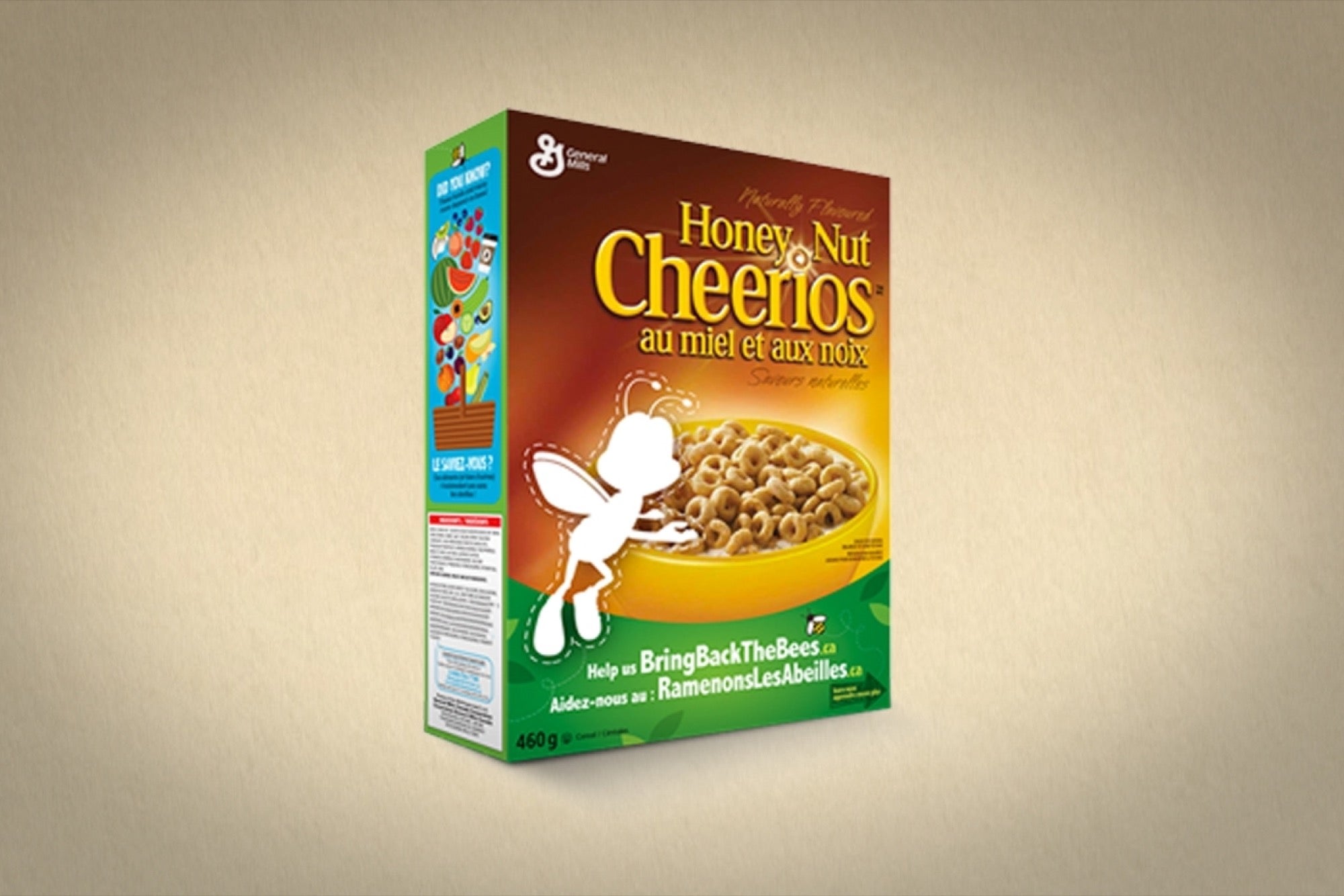Where on Earth Is Buzz? Why Honey Nut Cheerios Nixed Its Busy Bee. General Mills Canada aims to put a cause-marketing bee in your bonnet about the horrifying plight of our pollinating friends. But first, your contact information, please.
Opinions expressed by Entrepreneur contributors are their own.

Cheers to Cheerios for speaking for the bees.
The legacy cereal brand is stirring up a big buzz about the plight of our winged friends. ICYMI, the insects that the human race relies on for pollinating one out of every three bites of the food we need to survive are vanishing. They're eerily abandoning their colonies and dying off in record numbers.
To draw attention to the worsening global crisis -- and perhaps to ease the sting of growing public concern surrounding its use of genetically-modified ingredients and other unfun exposure -- General Mills Canada has strategically yanked Buzz, its iconic mascot. The bee has officially bugged off of its Honey Nut Cheerios boxes. A blank white silhouette of the bubbly honeybee is all that's left in his absence.
Related: Food Blogger Strikes Again, Taking On Chemicals in Cereal
The Lorax would be proud. So would Morgan Freeman and Ellen Page. Cosette, the ad agency behind the brilliant marketing maneuver, sure is.
"General Mills' decision to draw attention to the issue of declining bee populations marks the continuation of its commitment to purpose-based marketing, which means brands will go beyond traditional statements such as product benefit in order to align with what's really important to consumers," Cossette chief creative officer Peter Ignazi told AdWeek. "By taking the bold step of removing a well-established brand symbol from its packaging, General Mills is further challenging marketing's conventional thinking to underscore its point."

In step with its latest "cause marketing" crusade, the legacy brand also released a heartstring-tugging video. The clip (featured above) depicts one emotional animal rescue after another, set to the sound of a chorus somberly singing Mr. Mister's 1985 hit "Broken Wings."
Related: Cause Marketing Matters to Consumers
"Helping is in our nature," declare splashes of text floating over touching imagery. "Now another friend needs our help. The bees need us." Next is the here's-where-you-come-in call to action: "Join us in planting 35 million wildflowers to help the bees."
The company launched the feel-good campaign last Monday, companion website and catchy hashtag included. "Buzz is missing because there's something serious going on with the world's bees," the thoroughly branded website reads. "With deteriorating bee colony health, bees everywhere have been disappearing by the millions and it's time we all did something about it."
Related: Dislike: If You 'Like' General Mills on Facebook, You Can't Sue the Company
Heartily agreed. We'll drink the sweet leftover cereal milk to that. If we lived in Canada, we might even be inspired to plant a Veseys's wildflower seed, too. The cereal maker is giving away free flower seed packets from its cross-promotional partner in the hopes that Canadians will plant 35 million wildflowers to sow the seeds for healthier bees. (There's a catch: To get the seeds, you must first enter a Honey Nut Cheerios contest, which involves handing over a bunch of your direct contact information.)
Longtime beekeeper Rob McFarland, president and co-founder of Los Angeles-based HoneyLove, a nonprofit honeybee conservation organization, says the buzzy campaign is a thoughtful first step in a much-needed larger effort.

"I think it's a really creative, encouraging way to get the conversation started," he told Entrepreneur. "We'd like to see efforts like these go a step further. We'd like to see companies like General Mills really stepping in, in a big way, to do even more things that would make a difference. For example, ensuring that the farms they're sourcing their products from are planting hedgerows and planting plants for pollinators."
Related: Why This $34 Billion Company Is Dipping a Toe Into Crowdfunding
Not everyone is as moved by Buzz moving aside. Maryam Henein, the director of Vanishing of the Bees, a 2010 documentary that explores the environmental ramifications Colony Collapse Disorder, dismisses the personified bee being backburnered as little more than a clever "healthwashing"-reminiscent corporate publicity stunt.
"Sure, on the surface it's a positive attempt to create awareness," the investigative journalist and HoneyColony editor-in-chief told us. "Nutritionally, Honey Nut Cheerios is crap, quasi-healthy at best. Based on my research and others' extensive research prior, General Mills most likely uses "funny honey,' commercially-produced, compromised honey that's heated and dead, not raw and nourishing, so this whole do-good campaign is ironic."
"Honey" is listed as the fifth ingredient on the cereal's nutrition label, honey that General Mills goes out of its way to position as pure and natural. To be fair, it bears noting that the company has recently supported several initiatives to protect honeybees in their natural habitats.
Related: OK, You Can Sue Us: General Mills Scraps Controversial Terms of Service Updates
We reached out to the Minneapolis, Minn.-based American arm of the corporation to find out if it plans on following its Canadian cousin in temporarily benching Buzz, and to ask where both divisions source their honey and other Honey Nut Cheerios ingredients from. We have yet to receive a response.
Buzz being M.I.A. is a first for Honey Nut Cheerios, but the cute little bugger won't be gone for long. He's on official hiatus north of the border reportedly until July. At least while General Mills Canada does its part to make sure you don't mind your beeswax about the declining bee population.
Related: Should You Care About the Bees?
The honey- and almond-flavored version of the original Cheerios was first introduced in 1979. Don't worry: no water-hogging almonds are used in the making of the whole grain oat breakfast food. General Mills stopped adding real nuts to its recipe in 2006 in favor of "natural almond flavor." The nutty tang actually comes from the pits of apricots and peaches. Who knew?










